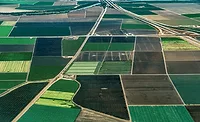Walmart, IBM and the Romaine Blockchain
What food processors and the entire supply chain should be doing to make our food safe

Food Engineering features some thoughts on the recent Romaine lettuce contamination by Aaron Cohen, co-founder of CoInspect and adjunct professor at New York University where he teaches the History of Internet Media. Wayne Labs, FE senior technical editor, conducted an exclusive, one-on-one interview with Cohen, immediately following Cohen’s text. Cohen has been CEO of several technology companies including MenuPages, which was acquired by Seamless.
In mid-March, the CDC started issuing warnings about an E.Coli outbreak in romaine lettuce from Yuma, Arizona. As it turns out, nearly all the romaine consumed in America from November to April is grown in the Yuma region. As of this week, 121 people have reported illnesses across 25 states, with 52 people requiring hospitalization—14 with kidney failure. While, one person has died from this particular foodborne illness outbreak, food safety is an increasingly serious public health crisis. In addition to the romaine outbreak, there have been 38 food-related recalls filed with the FDA just in the month of April.
Walmart, one of America’s most powerful food companies, has been publicly advancing the notion of a new food safety solution built on the promise of the next great technological breakthrough—Blockchain technology. Together with IBM, they have conducted a few experiments and gathered the business media to promote their results. Predictably, the blogerati in the food technology sector are now promoting Blockchain as the panacea to the safety issues plaguing America’s food industries. And it might be—if we can get more food service companies using digital solutions instead of pen and paper systems.
Blockchain is a shared database of continuously updated and encrypted transactions. Instead of companies all running complex proprietary systems, they would share a standard blockchain solution that would decentralize the proprietary ownership of data. For Walmart, this makes huge sense because they want to sell romaine lettuce that will not make anybody sick. The best way to do that is to know exactly where that lettuce has been from the moment it was planted, through harvesting, transporting and delivering it to their stores. If every company was using the same Blockchain solution, Walmart would know everything about that head of lettuce because they could track every step from the farm to the shelf.
Walmart’s safety initiatives should be admired. Long before Chipotle’s food safety crisis cost the company billions in market capitalization, Walmart recognized that every food service company is only one food safety crisis away from massive brand destruction. A decade ago, Walmart pushed the Global Food Safety Initiative (GFSI) as a new standard. Five years later, Walmart and its immensely well-regarded Food Safety Executive, Frank Yiannis, unveiled SPARK, a paperless auditing system that integrated early versions of bluetooth thermometers. Innovations like these protect the brand, shareholders, reputation and customers. For a company with a legendarily thrifty culture, Walmart has a long history as a technology-forward retailer. Food safety has not been an exception and the world’s largest retailer has invested heavily to protect its food supply chain.
But while this system was deployed throughout Walmart’s corporate network, it did not penetrate their supply chain deeply. The result: Most of Walmart’s thousands of suppliers still conduct GFSI audits on paper that get filed in cabinets. IBM and Walmart want to introduce Blockchain throughout the food industry, but the core technologies of the food safety industries are paper and pens.
We founded CoInspect because of a major challenge with the techno-utopian promise of food safety: When it comes to the inspection, compliance, and auditing data, nearly all food companies collect their data with a clipboard, paper, and pen. Analog data stored in a file cabinet won’t get encrypted into a Blockchain because, well, it’s not digital.
Looking for quick answers on food safety topics?
Try Ask FSM, our new smart AI search tool.
Ask FSM →
Those that work at the vanguard of food safety technology are enthusiastic about the promise of many new technologies to prevent food safety crises. Digital sensors that measure temperature and moisture will be far better than our current systems. Digital photography has enormous potential for auditing, training, and corrective action improvements. But food is fragile and complicated. Human observation is central to the detection of quality. That’s why the USDA employs thousands of meat inspectors to watch over America’s meat processing facilities. What those inspectors see with their own eyes is what keeps much of our food safe. Their observations are recorded largely on paper.
The Romaine Blockchain is a critical initiative for an America that is shifting to fresher, more fragile ingredients. But there is no food Blockchain without safety data that is digitally recorded and stored every step of the way. Ultimately, this means IBM and Walmart need to deeply consider the importance of human factor design in collecting data. Otherwise, the vast majority of critical safety data will never make it into the shared database. Because of the paper records—the system of choice among many in the food service industry—it will be difficult or impossible to know exactly where and how the E.Coli romaine outbreak began and spread.
FE had some questions for Aaron Cohen, and they follow.
FE: Is there specifically a “Romaine Blockchain” initiative underway? If so, who is supporting it?
Cohen: No romaine Blockchain that I am aware of but it’s fairly clear that the country needs one.
FE: You mentioned that too many food service companies are still paper based. What do you see with food processors/producers? Are the large companies prepared adequately for electronic recordkeeping? What about medium-sized and small food processors?
Cohen: I’ve spent considerable time in one of the largest pork processing plants in the country that produces over a billion pounds annually. It was superbly run, but their myriad of QA and safety inspectors used a combination of clipboards, colored forms and digital cameras to record data. Sometimes these clipboards were mobile, and sometimes they were part of a station.
As for the thousands of small and medium producers it’s all paper. FSMA has raised the stakes for all companies and a cycle of adoption has begun.
FE: Are the farms behind the eight-ball in terms of providing electronic tracking and tracing for their shipments?
Cohen: Depends on the farm and the demands placed on them by their buyers. Generally farming of any kind—from produce to chickens—is very fragmented and the idea of running Internet-of-Things sensors connected to software is not a top priority. However, when food purchasers demand it as a condition of doing business we will see a rapid proliferation of technologies.
FE: As I follow plant opening announcements, I’m beginning to see a shift toward many large-scale, enclosed greenhouses (e.g., 30-plus enclosed acres) with hydroponics used throughout to grow safe food. Since they’re already using technology heavily, I would expect they’re already using electronic record keeping. What’s your take on this?
Cohen: I don’t have a specific answer to this. We do have some newer companies in the meal delivery and prepared foods industries that are more technology-forward. Still, as you know, most of the country’s food is produced by a small number of plants and companies.
FE: There are several wireless systems—many cellular—now available for truck-based carriers to track time, temperature, humidity and other process variables in real time. Are you seeing these devices being tied into a Blockchain system? Who is spearheading this, if anyone?
Cohen: These are exciting developments and I would expect these technologies are one easy integration to a future Blockchain solution. Still, apples move around the country in different trucks and speeds. We need a critical mass of transportation vendors to integrate this technology before any supply chain solution—Blockchain or not—can be viable.
FE: Is CoInspect using the Walmart/IBM Blockchain system? How does it work?
Cohen: We don’t for two reasons. First, we make software that stores and codes the data into a Blockchain friendly format. Second, most of what you have read from IBM and Walmart are experiments that are unlikely to be products at this stage for wide adoption. Ultimately, inspectors and field workers will use CoInspect to create the data stored and encrypted in the Blockchain.
FE: Can CoInspect tie into existing food safety and/or quality management systems that food processors may already be using (e. g., SafetyChain, TraceRegister, Icicle, etc.)? What can it bring to the table?
Cohen: Companies purchase our software because it is very easy to use and our content management capabilities allow companies to quite easily painlessly migrate from paper and excel to a digital solution that easily integrates with any standard solution.
FE: I asked Bridget Van Kralingen, senior vice president, IBM Industry Platforms about the potential of several Blockchain platforms becoming available, which could conceivably present incompatibility issues among systems—so they don’t “talk” to one another. What’s your opinion on this? Are a handful of platforms better than just one or none?
Cohen: I’m much less worried about this issue than companies recognizing how Blockchain is going to force unprecedented levels of transparency. The first 50 years of the digital revolution have made proprietary data an asset. Blockchain makes this data shared, exposed and owned by a group of organizations. This is a massive shift in business process and eventually will have regulatory and other legal consequences.
FE: How old or new is CoInspect? Do you have a patent or have you applied for a patent?
Cohen: We have just begun our third year working with the food industry with a principal interest in restaurant chains and small manufacturers. We do have intellectual property interests at the intersection of checklist science, food safety and mobile technological solutions.
About CoInspect:
Aaron Cohen co-founded CoInspect to make food safer and filing cabinets obsolete. CoInspect software powers food safety, quality assurance, and standards management for restaurants and food manufacturers. The company's obsession: Make software that is fast, flexible, and easy-to-use. For more information, visit www.coinspectapp.com or reach him at aaron@coinspectapp.com.









